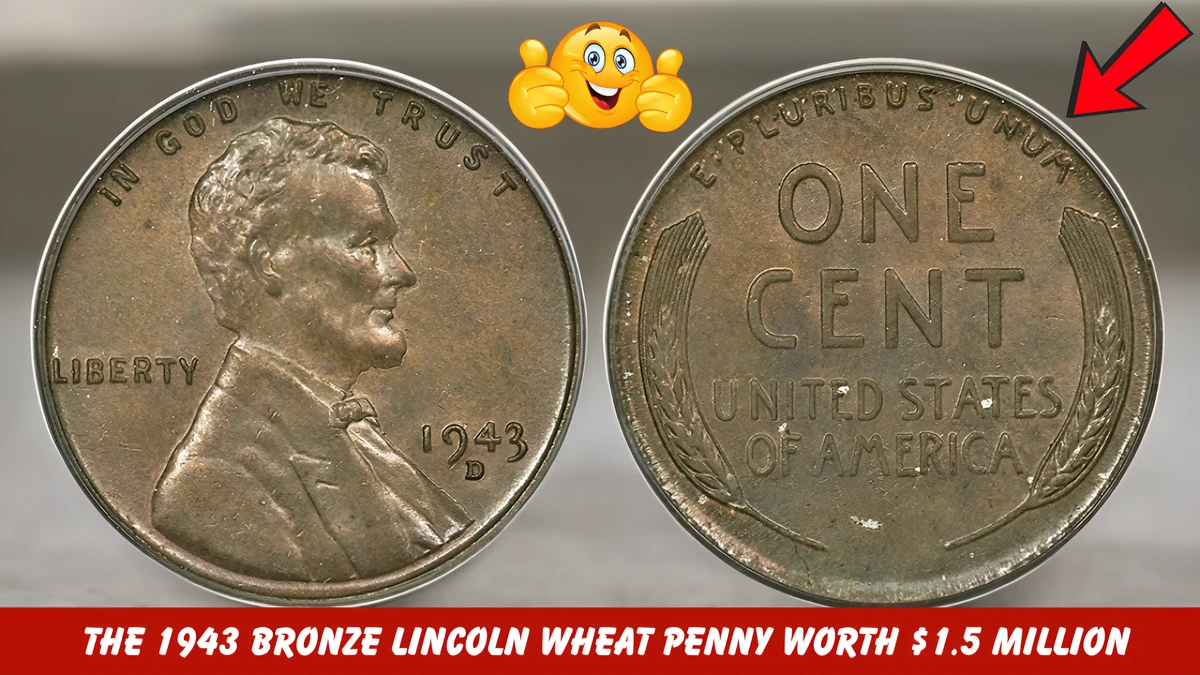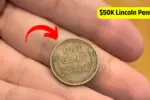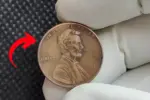Imagine finding a penny in your pocket change that could turn your financial future around. As incredible as it sounds, this isn’t just a fantasy but a possibility, thanks to the mysterious 1943 Bronze Lincoln Wheat Penny. Valued at a staggering $1.5 million, this unique piece of history has captured the fascination of collectors worldwide. Its rarity, historical significance, and potential to still be in circulation make it one of the most intriguing coins ever minted. Let’s journey into the world of numismatics to uncover the story of this extraordinary penny.
A Glimpse into History: The Lincoln Wheat Penny
The Lincoln Wheat Penny, also referred to as the “Wheat Cent,” has been an iconic part of American coinage for decades. First minted in 1909, it was introduced to honor the centennial of Abraham Lincoln’s birth the first U.S. coin to feature a real person.
The coin’s obverse, designed by Victor David Brenner, showcases a dignified profile of Lincoln. On the reverse, two wheat stalks frame the phrase “ONE CENT,” symbolizing growth and prosperity. Produced until 1958, this design remains a favorite among collectors for its simplicity and historical charm.
The Turning Point: World War II’s Impact on Pennies
The tale of the 1943 Bronze Lincoln Wheat Penny begins during the tumultuous times of World War II. With the global conflict escalating, the U.S. government faced a critical shortage of copper a material vital for manufacturing ammunition and military equipment. In response, the U.S. Mint decided to temporarily alter the composition of pennies to conserve resources.
As a result, the year 1943 witnessed the production of pennies made from steel coated with zinc. These “steel cents” had a shiny, silvery appearance and were lightweight, becoming a distinctive anomaly in the history of Lincoln Cents.
A Minting Mistake: The Birth of the 1943 Bronze Penny
Despite the meticulous planning that went into transitioning from copper to steel, a small number of bronze blanks were mistakenly left in the Mint’s coin presses. These bronze blanks were struck with the 1943 design, resulting in a minting error that produced the 1943 Bronze Lincoln Wheat Penny.
The rarity of this coin cannot be overstated. Experts estimate that only 15 to 20 examples of the 1943 Bronze Penny exist today, with discoveries spread across Philadelphia, Denver, and San Francisco Mints. Each of these pennies is a testament to the unpredictability of minting processes during challenging times.
The Rarity Factor: Why Is It Worth $1.5 Million?
The value of any collectible lies in its rarity, historical importance, and desirability, and the 1943 Bronze Penny excels in all these aspects. Its accidental creation makes it a unique artifact from a pivotal era in world history.
Beyond rarity, the coin’s composition serves as a tangible reminder of the resourcefulness and challenges of the wartime era. Its connection to Abraham Lincoln a symbol of resilience and leadership further enhances its allure.
Add to this the passionate pursuit of numismatists (coin collectors) and the coin’s impeccable pedigree, and it’s easy to see why one of these pennies was auctioned off for $1.7 million in 2010. Today, its value is estimated at $1.5 million, but that figure could easily climb higher as time goes on.
Could There Be More Out There?
The most tantalizing aspect of the 1943 Bronze Lincoln Wheat Penny is the lingering possibility that one could still be in circulation. Coins often remain in circulation for decades, especially if they go unnoticed by casual handlers.
Theoretically, a 1943 Bronze Penny might be lying dormant in someone’s old jar of coins, a dusty attic collection, or even in a cashier’s register. Stories abound of lucky individuals discovering rare coins in the unlikeliest places, fueling dreams of stumbling across such a treasure.
How to Spot a 1943 Bronze Penny
If you’re an aspiring treasure hunter, keep an eye on your coins. Identifying a 1943 Bronze Penny requires a mix of attention to detail and simple tests:
- Year: Check that the penny is dated 1943.
- Color: A bronze penny will have a copper-like appearance, unlike the silvery steel cents.
- Magnet Test: Bronze pennies are not magnetic, whereas steel cents will stick to a magnet.
- Weight: Use a precise scale to weigh the coin. A genuine bronze penny weighs around 3.11 grams, while steel cents are lighter.
If you suspect you have one, consult a professional numismatist or send it to a coin-grading service like the Professional Coin Grading Service (PCGS) for authentication.
What to Do If You Find One
Discovering a 1943 Bronze Lincoln Wheat Penny could be life-changing, but handling it correctly is crucial. Here are a few steps to maximize its value:
- Avoid Cleaning the Coin: Cleaning can damage the surface and reduce its worth significantly.
- Get It Authenticated: Ensure that your discovery is verified by a reputable grading service.
- Seek Expert Advice: Consult a numismatist to determine the best way to sell or auction your penny.
- Protect the Coin: Store it in a protective case to preserve its condition.
The Broader Appeal of Coin Collecting
While the 1943 Bronze Penny is a standout example, it also underscores the broader appeal of coin collecting as a hobby. Each coin tells a story, offering a glimpse into the culture, economy, and events of its time. Collecting coins fosters a deeper appreciation for history and often leads to surprising discoveries.
Whether you’re a seasoned numismatist or someone casually interested in coins, the thrill of finding a rare penny especially one worth $1.5 million is universal.
Conclusion: A Treasure in Your Pocket
The 1943 Bronze Lincoln Wheat Penny isn’t just a piece of metal; it’s a symbol of history, perseverance, and the unexpected treasures hidden in everyday life. Its story reminds us that remarkable discoveries often come from the most unassuming places.
So, the next time you sift through your pocket change, take a moment to examine each coin carefully. Who knows? That humble penny in your hand could hold a million-dollar secret, waiting for you to uncover it.
FAQs
How many 1943 Bronze Lincoln Wheat Pennies are known to exist?
Around 15 to 20 genuine examples are known worldwide
Why were most 1943 pennies made of steel instead of copper?
Copper was needed for ammunition during World War II
How can I test if I have a 1943 Bronze Penny?
Use the magnet test — bronze isn’t magnetic but steel is
Can I clean the coin to make it look better before selling?
No — cleaning can reduce its value significantly
What should I do if I think I found a 1943 Bronze Penny?
Get it authenticated by a professional coin grading service.



